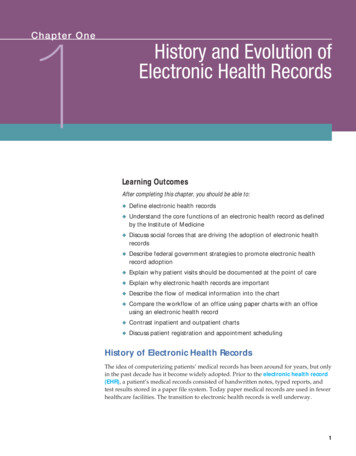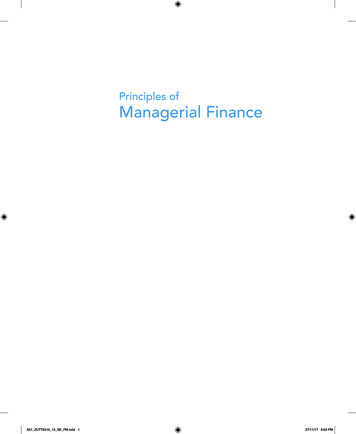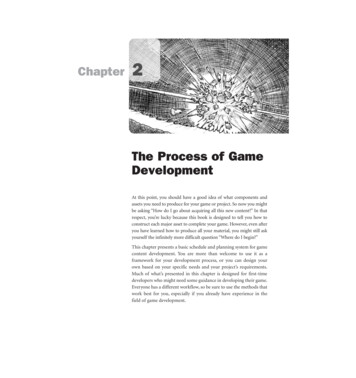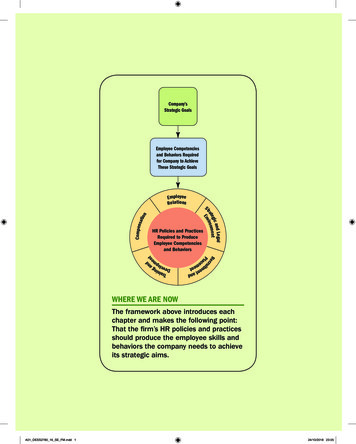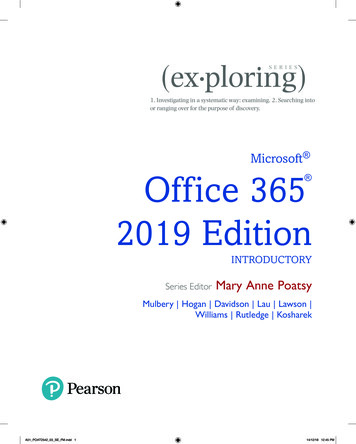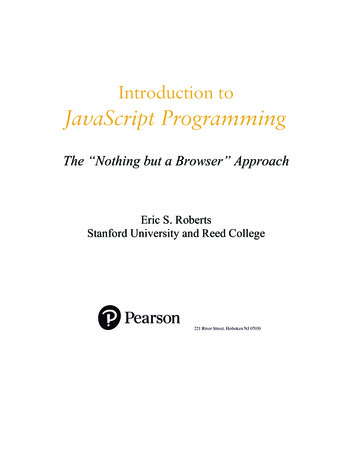
Transcription
Introduction toJavaScript ProgrammingThe “Nothing but a Browser” ApproachEric S. RobertsStanford University and Reed College
Senior Vice President Courseware Portfolio Management:Engineering, Computer Science, Mathematics, Statistics,and Global Editions: Marcia J. HortonDirector, Portfolio Management: Engineering, ComputerScience, and Global Editions: Julian PartridgeExecutive Portfolio Manager: Tracy JohnsonPortfolio Management Assistant: Meghan JacobyManaging Producer, ECS and Mathematics: Scott DisannoSenior Content Producer: Erin AultManager, Rights and Permissions: Ben FerriniOperations Specialist: Maura Zaldivar-GarciaInventory Manager: Bruce BoundyProduct Marketing Manager: Yvonne VannattaField Marketing Manager: Demetrius HallMarketing Assistant: Jon BryantCover Design: Black Horse DesignsCover Image: philipp igumonov/GettyComposition: Eric S. RobertsCover Printer: Phoenix ColorPrinter/Binder: Lake Side Communications, Inc. (LSC)Typeface: Times New RomanCopyright 2020 Pearson Education, Inc., Hoboken, NJ 07030. All rights reserved. Manufactured inthe United States of America. This publication is protected by copyright, and permission should beobtained from the publisher prior to any prohibited reproduction, storage in a retrieval system, ortransmission in any form or by any means, electronic, mechanical, photocopying, recording, or otherwise.For information regarding permissions, request forms and the appropriate contacts within the PearsonEducation Global Rights & Permissions department, please visit www.pearsoned.com/permissions/.Many of the designations by manufacturers and seller to distinguish their products are claimed astrademarks. Where those designations appear in this book, and the publisher was aware of a trademarkclaim, the designations have been printed in initial caps or all caps.The author and publisher of this book have used their best efforts in preparing this book. These effortsinclude the development, research, and testing of the theories and programs to determine theireffectiveness. The author and publisher make no warranty of any kind, expressed or implied, with regardto these programs or the documentation contained in this book. The author and publisher shall not be liablein any event for incidental or consequential damages in connection with, or arising out of, the furnishing,performance, or use of these programs.Library of Congress Cataloging-in-Publication DataNames: Roberts, Eric, author.Title: Introduction to JavaScript Programming / Eric S. Roberts, Stanford University.Description: First edition. Pearson Education, Inc., [2020] Includes index.Identifiers: LCCN 2018054226 ISBN 9780135245859 ISBN 0135245850Subjects: LCSH: JavaScript (Computer program language)Classification: LCC QA76.73.J39 R59 2019 DDC 005.2/762--dc23LC record available at https://lccn.loc.gov/20180542261 19ISBN 10:0-13-524585-0ISBN 13: 978-0-13-524585-9
To Lauren, with love
To the StudentWelcome! By picking up this book, you have taken a step into the world ofcomputer science. Twenty-five centuries ago, the Chinese philosopher Lao-tzuobserved that the longest journey begins with a single step. This book can be yourbeginning.Computing is a profoundly empowering technology. Jobs are plentiful, salariesare high, and there are far too few people with the necessary skills to fill those jobs.Computation, moreover, is transforming almost every discipline, not just in scienceand engineering but also across the entire university curriculum. No matter whatfield of study you choose, understanding how to use computing effectively will beof enormous value.To get you started on your journey into the wonders of computer science, thisbook teaches you how to write programs in a language called JavaScript, which is acentral technology for web-based applications. The programs you create as you gothrough this book will run in any web browser, including the browser on yourphone. More importantly, however, the book will teach you the fundamentalprinciples of programming. While it uses JavaScript to illustrate these principles,they will carry over into any other language that you learn.As with any skill that is worth knowing, programming will not necessarily comeeasily. Many students find computers overwhelming and imagine that computerscience is beyond their reach. Learning the basics of programming, however, doesnot require advanced mathematics or a detailed understanding of electronics. Whatmatters is whether you can progress from the statement of a problem to its solution.To do so, you must be able to think logically and to express your logic in a formthat the computer can understand. Perhaps most importantly, you must be able tosee the task through to its completion without getting discouraged by difficultiesand setbacks. If you stick with the process, you will discover that reaching thesolution is so exhilarating that it more than makes up for any frustrations along theway.I wish you an exciting and empowering journey.Eric RobertsStanford UniversityJanuary 2019iv
To the InstructorThis book is designed for use in the first programming course in a typical college oruniversity curriculum. It covers the material in a traditional first course in computerscience, generically referred to as CS1. The book assumes no prior programmingexperience and is appropriate both for prospective computer science majors and forstudents in other disciplines who are interested in learning the fundamentals ofprogramming.The book uses a programming language called JavaScript, which is one of themost widely used languages in industry and has become the standard language forwriting interactive web applications. Because of its popularity, JavaScript is builtinto every major web browser, which means that any device with a browser can runJavaScript programs without any additional software. The focus of this text,however, is on the fundamental concepts of programming rather than the language.It does not cover all of JavaScript and avoids several aspects of the language thatstudents are likely to misuse. The subset of JavaScript employed in this bookprovides students with more than enough power to write exciting programs that runin any web browser.The case for using JavaScript in CS1As a discipline, computing is always changing. These changes can be profoundlyexciting, particularly for students who have grown up in the digital world. Foreducators, the breakneck pace of development creates challenges that invariablyextend even into the earliest levels of the curriculum. As languages, tools, andparadigms shift, teaching strategies must evolve to remain current.Two decades ago, the Java programming language, with its support for applets,looked like the wave of the future and seemed likely to become the standard forweb-based programming. That didn’t happen. By the early 2000s, Java applets hadbeen abandoned in favor of the ubiquitous blend of JavaScript, HTML, and CSSthat serves as the foundation for web applications today.Once it was clear that JavaScript had triumphed in the race to become thelanguage of the web, several of my colleagues and I began to think about using it inStanford’s introductory programming course. Much of our original motivation forchoosing JavaScript came from our excitement about a “Nothing but a Browser”model in which students—even those with no access to computers other than asmart phone—could work entirely in the web environment. When we beganteaching the JavaScript version of our introductory course, we found that thebrowser-based model worked exactly as we envisioned. Students no longer have toinstall and use a separate development environment. All they need is a webv
browser, which every student has. They are also able to add JavaScript content totheir own web pages, which increases the students’ incentive to learn the materialand encourages them to show off their work.Beyond the advantages of the web-based model, we were delighted to discoverjust how well JavaScript works as a teaching language. Students can master theessentials of JavaScript much more quickly than their predecessors learned Java.As Douglas Crockford, who developed the widely used JavaScript Object Notationdescribed in Chapter 9, observes, JavaScript is “a beautiful, elegant, highlyexpressive language,” even though it is often used in the context of other webtechnologies that share little of that elegance. If you focus on the JavaScriptlanguage itself, its beauty and elegance make teaching JavaScript much simpler thanteaching other languages, with far fewer confusing details to explain.The relative simplicity of JavaScript is reflected in the length of this textbook,which is 30 percent shorter than my Java book for the same course. Despite beingshorter, the JavaScript version covers at least 25 percent more material. In part, theeconomy of presentation reflects the fact that JavaScript programs are shorter thanthe same programs written in Java. Of even greater importance, however, is the factthat the parts of those programs that disappear in the transition from Java toJavaScript are precisely the parts that would have required the most explanation.Pedagogical approachIntroduction to JavaScript Programming relies on three proven strategies tomaximize students’ understanding. First, it introduces the concepts of programmingusing a JavaScript version of Rich Pattis’s wonderful Karel the Robot microworld,which has gently welcomed Stanford students to the world of programming foralmost 40 years. Although it is possible to skip the Karel chapter, we have foundthat the increased conceptual understanding students derive from that introductionmore than repays the time. Second, the book adopts the programming guidelinesrecommended by Douglas Crockford in JavaScript: The Good Parts, which outlineshow to write elegant, well-structured programs in JavaScript. Third, the bookpresents topics in an order that defers the most challenging topics until studentshave the necessary background. For example, the detailed discussion of howJavaScript works together with other web technologies like HTML and CSS appearsin Chapter 12, after students have already completed chapters on data structures andinheritance.vi
Pedagogical featuresThe text uses the following features to enhance student learning: Chapter openers. Every chapter begins with a photograph and short biographyof someone who has had a major impact on computing. These biographies, andthe diverse backgrounds of the people included, emphasize the human side ofcomputing. Key terms. Each new term in the text appears in boldface italic and is followedimmediately by a definition. Syntax boxes. Each new syntactic form is summarized in a highlighted box thatappears in the margin of that page. Syntax coloring. The major program examples appear in numbered figures thatuse syntax coloring to ensure that students can easily differentiate comments,keywords, and string constants from the rest of the code. Source code. The source code for all the sample programs is available on theweb site for the book. The programs, moreover, all run in any browser. Chapter summary. Each chapter includes an extensive summary that lists thekey ideas introduced in the chapter. Review questions. Each chapter summary is followed by review questions thatprovide a self-test of student understanding. Answers to the review questionsappear on the web site. Programming exercises. Each chapter ends with an extensive set of exercisesthat test whether students understand the chapter material while giving themopportunities to create exciting applications.Resources for the instructorThe following resources are available to instructors who adopt this textbook on thePearson Instructor Resource Center (http://www.pearsonhighered.com/irc): Guide to the instructor. Teachers who adopt the text receive an instructor’sguide that includes additional examples, recommendations for projects andprogramming assignments, hints on pedagogical strategy, and suggestions forpossible variations in the order of presentation. Lecture slides. The web-based repository for the book includes a set of slides inMicrosoft PowerPoint for each of the 12 chapters. These slides illustrate thekey points in each chapter and include detailed animations of the programexamples. Solutions to the exercises. Adopters have access to a repository containingsolutions to the programming exercises.vii
Resources for studentsThe following resources are available at www.pearsonhighered.com/cs-resources: Program sources. The web site includes the source code for all sampleprograms presented in the text. The web pages for those programs also allowstudents to run the programs directly in the browser. Program animations. For several of the most important sample programs, theweb site makes it possible for students to step through the execution of theprogram so they can see it in operation. Answers to the review questions. The review questions serve as a self-test thatallows students to check their understanding. The answers to these reviewquestions are available on the web site.System requirementsThe most important advantage of using JavaScript in an introductory course is thatprograms run in any browser that implements HTML 5 and ECMA 6—both ofwhich are supported by all major browsers today. None of the JavaScript programsrequire features from more recent versions of JavaScript and in fact use onlyECMA 6 extensions that are typically supported even in older browsers.Although it is possible to use the interactive applications on the web site to writesimple programs without using any other tools, many students will find it easier touse a more powerful text editor to write and edit their programs. Many excellenteditors are freely available on the web, and we have found it best to let studentschoose an editor that fits their own needs rather than to impose a particular choice.viii
Ac
trademarks. Where those designations app ear in this book, and the publisher was aware of a trademark claim, the designations have been printed in initial caps or all caps. The author and publisher of this book have used their best efforts in preparing this book. These efforts





